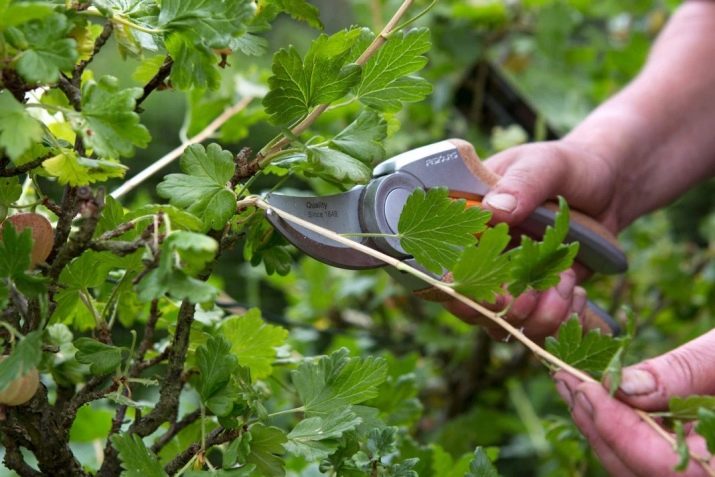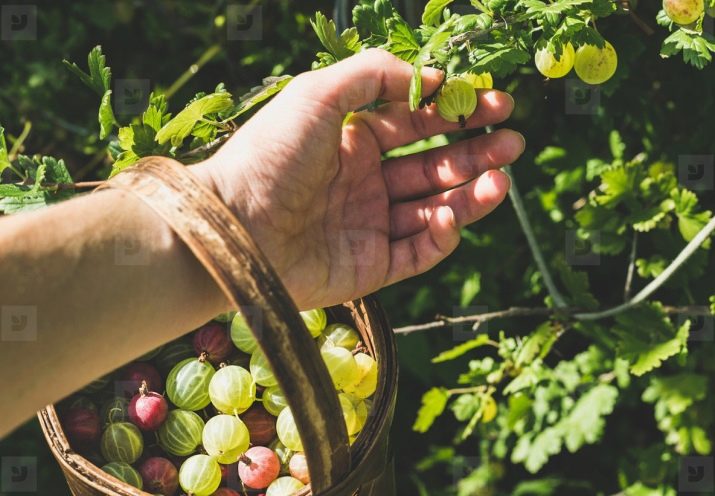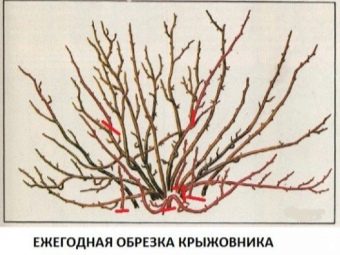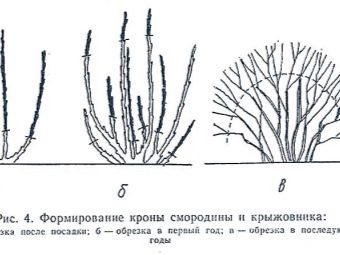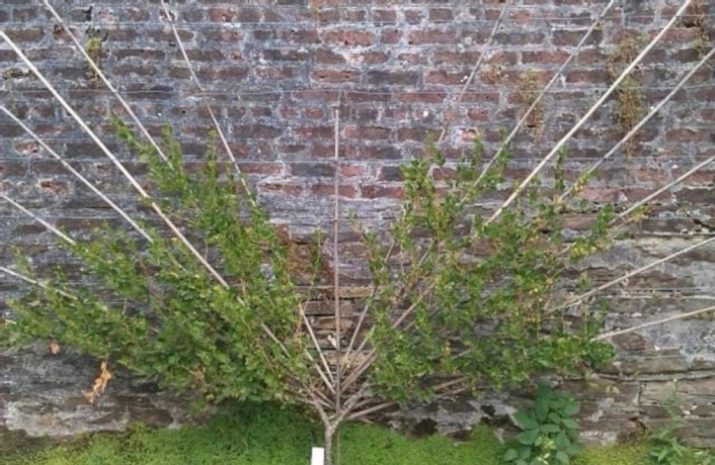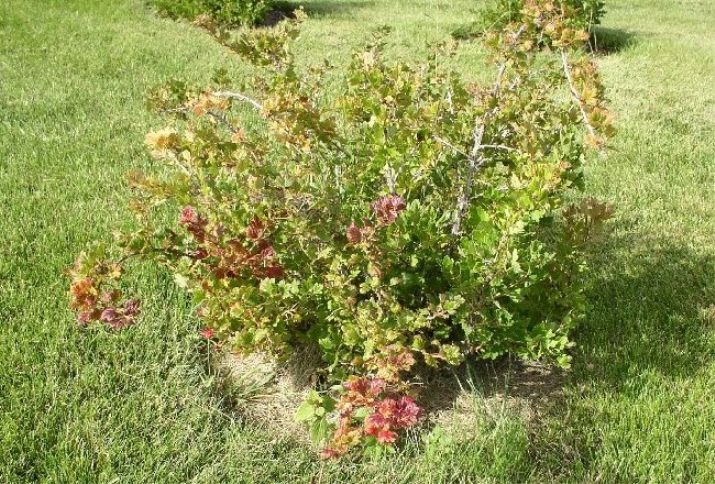How to cut gooseberries?
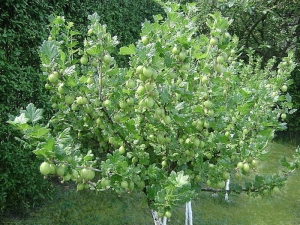
The process of growing horticultural crops includes many agrotechnical methods, among which the pruning of trees and shrubs is not the last value.This also applies to gooseberries, as well-formed shrubs produce greater yield.
What is it for?
Gooseberry bush is a perennial plant that grows up to one and a half meters. Different branches and basal shoots of different ages form a crown, which can also reach almost 1.5 m in diameter. Basal shoots are notable for their active growth in the first life year.
By autumn, the woodiness process is over, and next spring they will release young shoots, from which the skeleton (skeleton) of the bush will be formed. In turn, shoots appear annually on these branches, growing 8–30 cm in length. By autumn, these shoots will harden, cover with bark, that is, they will be real branches of the second order, which will give branches of the third order, and so on. Branches 1-3 orders of magnitude are the strongest and give the greatest number of berries. Systematic pruning will help to regularly update these branches, so that the crop was stable.
Gooseberry can quickly become thick due to new young shoots. This leads to the fact that the sun and the air do not penetrate deep into the bush, which leads to a decrease in yield and contributes to the emergence of diseases.
The purpose of pruning - to regulate the growth of new shoots, prune old, remove the sick and unnecessary. Therefore, it is so important to annually cut gooseberries, form its bush and get rid of unnecessary shoots. At the age of 5–6 years old black branches appear that need to be cut to rejuvenate the bush. Pruning contributes to the following factors:
- improvement of lighting and aeration of the inner part of the bush;
- reduce the possibility of the occurrence of diseases and colonies of harmful insects;
- increase in the volume and quality of the crop, as the dense crown prevents pollination and the ovary of the berries;
- to simplify the care and harvesting of berry crops - it is very difficult to do this from overgrown branches with a lot of thorns, without injuring your hands;
- rejuvenation of the gooseberry, which makes it possible to prolong its vital activity and fruiting, because when cutting off the entire shoot or part, there is an impulse from the root system to the branches, leading to the growth of young shoots.
In addition to all this, in the overgrown shrub berries become small. With a large number of stems, the share of each branch accounts for less nutrition, the number of fruits decreases, and their quality deteriorates. Grown long stems fall on the soil, give roots. As a result, the gooseberry ceases to yield and becomes the object of settlement by harmful insects.
There are these types of pruning:
- formative - Its purpose is to make the bush compact;
- sanitary - is carried out with the purpose of improving the gooseberry by removing diseased, broken, dry and damaged stems;
- rejuvenating - its purpose is to stimulate the growth of young shoots;
- preplant - it is done to stimulate its further growth, before planting the seedling, all the broken and beginning to dry branches are cut, and the remaining shoots are pruned, leaving no more than 4 buds.
Timing
Gooseberries are recommended to be pruned in spring, as well as after harvest in autumn.
Spring pruning should be done early, until the buds have blossomed and the movement of juices has begun. Gooseberry is an early crop, the buds swell in the second decade of March, and by the beginning of April the first leaves are blooming. When pruned after blooming, some of the nutrition will go to the kidneys, which will then be trimmed. So a lot of nutrients are wasted. Therefore, you need to pruning in the first half of March.
In the spring are removed:
- old blackened and horizontally growing shoots;
- branches with defects (broken, growing crookedly);
- the middle of the bush is thinned out; weak young and very high shoots are removed.
In one-year-old bushes in spring, it is recommended to cut off all the weakest branches and leave 3-4 strongest ones. This spring pruning done five years in a row.As a result, the bush will have about 25 strong and strong main branches, on which side shoots will grow.
But the most effective conduct of the autumn pruning and summer - the one that they do after harvest.
Summer pruning gooseberry is made immediately after picking berries. The main thing - to remove the appeared dry and with signs of disease branches. This pruning is often called sanitary. It is carried out around the end of July or early August.
And on the young shoots, the part from the top is cut off, leaving about 7 leaves on them. Shortening of old shoots in the summer should not be made, as this will cause the reproduction of young shoots. But the process of stiffening of such shoots will not have time to be completed before the cold weather and with the arrival of frost they will die.
Autumn gooseberry pruning is done after the end of the leaves, until the frosty weather is established. For the middle band this will be approximately in October-November.
Autumn cut:
- all newly appeared dry, damaged, old and with signs of disease branches;
- shoots that are very low growing and lying on the ground, since their growth occurs in the shade under insufficient light, which is why they are more likely to get sick;
- branches with the direction of growth in the center and in the inner part of the crown, which strongly condense the bush;
- shoots that prevent others from growing;
- young and weak shoots.
It must be remembered that the total number of cut branches should not be more than 1/3 of the total number of branches in the bush.
How to do the work?
In order to make pruning, you need to have a special tool. This pruner, which are cut thin branches, and lopper for cutting thicker and more powerful shoots. Since the gooseberry has very sharp thorns, thick gloves will be needed.
Autumn pruning should be carried out according to a scheme developed by gardeners for a long time.
- All outdated and low-growing branches should be cut to the level of the soil surface, not leaving even small knots. The thickness and color distinguish the ancient branches from the young. The obsolete ones are thick and dark brown (almost black), while the young ones are rather thin, and the color is light.
- Unwanted shoots and rival stems are also cut, leaving no knots and as close as possible to the branch. The young shoot is left, and the old one is cut down to the place of young growth.
- In order to better branch the underdeveloped branches, they are shortened, first determining the strongest bud, and then cutting off the shoot at a distance of no more than one centimeter from this bud.
- In one-year-old bushes, branches are shortened, leaving only 4 buds on them.
After pruning, all cut sections that have a diameter greater than 8 mm must be covered with a garden pitch. It is also important to remember that sections should be made above the kidney approximately 1 cm and at an angle of 50 degrees.
Pruning bushes of different years of life is distinguished by its features and techniques.
Pruning in 1 year is preplant trimming. On the sapling you need to shorten all the branches, and on strong shoots save only 4 buds from the ground, and on the underdeveloped - no more than two. The purpose of such pruning is to provide the young bush with sufficient nutrition and the creation of skeletal branches forming the framework of the bush.
During the growing season, the root system will develop and give new shoots. Autumn pruning this year is limited by the fact that they determine about 6 healthy and powerful shoots, which after shortening leave to winter.
Second year. The following year, in the spring, they also choose well-placed 5 strong zero branches. Underdeveloped shoots less than 20 cm must be removed altogether. Powerful vertical and slightly bent branches make shorter, leaving processes about 30 cm long, which contributes to further branching. Shoots growing horizontally, cut off completely.
By the third year, the gooseberry should have about 18 branches of different ages, and they form the skeleton of the bush. This is achieved in this way:
- all horizontal branches are cut off completely (this also applies to underdeveloped processes);
- left healthy branches cut off from the top of 15 cm.
In the fourth year, the four-year-old gooseberry bush is considered an adult and begins to produce a large number of berries, which does not exclude the need for further cutting and supporting the shape of the bush.
Pruning this year is to regularly cut crookedly grown and weakly developed unhealthy branches. Young processes are also removed in a timely manner, including those grown from the neck of the roots, which excludes the growth of horizontal branches. By this time, the gooseberry should be about 16-20 different age branches.
Further annual pruning of the gooseberry is done in a similar way. When reaching 7–8 years old, they begin to make anti-aging pruning. With this method you can cut no more than 1/3 of the branches of the total number.
- First, black old, crooked, underdeveloped, with signs of branch disease are removed.
- The left strongly developed basal branches inspect the tops. Having defects (dry, broken) are cut to the place of a branch from a healthy escape.
At 10-year-old and older bushes carry out a cardinal pruning: 5 of the most powerful and healthy branches are left, the rest are completely removed. If this is done in a timely manner, then the bush gives a new young generation of shoots. This pruning is preferable to do in early spring.
When performing pruning, you should not forget such rules:
- if the branch for the year gave few shoots, then it is underdeveloped and it must be cut to the side branch with a good escape;
- about the underdevelopment of the branch indicates its thin end, it is cut to the largest kidney, directed outwards;
- good branching of the gooseberry helps pruning of zero shoots by one fourth of their length;
- Cutting a branch above the kidney and from the outside of it, you can prevent the bush from compacting, because the shoots will not have an internal direction, but an external direction of growth.
An old and very overgrown, non-fruiting gooseberry bush can be revived and restored to good fruiting. Anti-aging pruning is desirable to carry out in two steps.
Sanitary pruning is done first. If it is made in spring, the bush is thinned and all black, broken, crooked and diseased branches are removed. And if it is carried out in the fall, then all the old branches are cut off entirely to the ground, which contributes to the emergence of new shoots in the spring.
Then make a rejuvenating pruning. Removed very old and horizontally grown branches. In the presence of vertical shoots retain 5 of the most healthy and strong, and the rest are also cut. On the branches yielding the harvest, dry ends are cut to the very first powerful side branching.
In the subsequent time, pruning of the old gooseberry is carried out, as usual, keeping the shape of the bush. But we must remember that in spring and autumn you can cut no more than 1/3 of the shoots. Overgrown gooseberries reborn about 4 years.
There is also such a cardinal method of restoring a neglected gooseberry: they cut all branches entirely to ground level, except for the 4 youngest and most powerful branches. A year after such pruning, a large number of sprouts will grow, some of which will be removed again, leaving about 5 strong, strong, well-placed.
When pruned, the bush is well fed with organic or mineral fertilizers, plentifully watered. After this method of cutting, the gooseberry bush is quickly reborn and can give berries in three years.
There are such extraordinary methods of cutting gooseberries and the formation of its bush: shtambovy and trellis.
Stam method of breeding gooseberry is to form a bush like a tree. For the trunk of the future, the trees leave the most powerful, growing up branch of a certain height (usually meter-high), and the lower side branches of the trunk are cut to the same height, cutting off the rest.
Shoots that grow on the shtambe later also removed.A tube of metal (or plastic) is put on the boles, which is deepened slightly into the soil. This facilitates the care of the trunk of the bush, and is also a support for it. Around the gooseberry drive a peg into which the trunk is tied up.
The subsequent formation is carried out as usual: 5 new powerful shoots are left every year, and last year’s seeds are cut off by half. The branches with the direction of growth inside the bush or down are removed, as well as the basal processes growing from the ground.
The disadvantages of this method are the short lifespan of the gooseberry (it cannot be rejuvenated) and poor cold resistance.
Trellis gooseberry cultivation method is carried out using trellis. Between the supports of the trellis tension 3 rows of wire at a distance of 50-80-100 cm from the soil. The gap between the bushes is approximately 0.7 to 1 m, and the distance between the trellis is one and a half meters.
The gooseberry bush starts from three or four branches, which are fan-tied to the bottom row of the wire at a distance of 20-25 cm. Their growth will subsequently be directed vertically upwards. The branches (3–5 strongest), having a horizontal direction of growth, having cut off a little beforehand, are also tied up on a trellis, and the rest are removed. A year later, these horizontal branches are fixed, not shortening, on the middle wire.
The main fan-shaped branches are shortened somewhat more than the horizontal ones: this is how the growth ratio is maintained. Each year, leave no more than 5 new shoots, and last year's shorten by a third (sometimes by half). Zero sprouts clean. After the fifth year, you can begin rejuvenation of the bush.
Aftercare
When growing gooseberry important place takes good care after pruning. In the autumn it consists of the following:
- around the trunk of a bush, the land is cleared of weeds, fallen leaves, and served mulch (prevention that prevents the preservation of harmful insects);
- the soil of the trunk circle is well loosened;
- bush is treated with means from harmful insects and diseases;
- top dressing is brought in and the earth is well watered;
- The soil is covered with fresh mulch for wintering.
After pruning fertilization is required. It can be both mineral and organic fertilizers. A shallow ditch (approximately 30 cm) is dug around the bush around the bush, and fertilizers are added to it and then added dropwise.
Spring dressings are designed to feed gooseberries before flowering and subsequent growth of fruit ovaries. Nitrogen fertilizers are applied at about 50–70 g per gooseberry.
Upon completion of berry picking and pruning, fertilizing with fertilizers contributes to the formation of fruit-bearing buds for the next year's harvest, as well as the accumulation of strength for the winter. During this period it is very effective to feed the bush with mullein. It is important to carry out preventive treatment with fungicides and insecticides.
Fertilizing in the fall, necessarily including potash-phosphate fertilizers, will facilitate gooseberry winter time and prepare for a new crop. And also it is necessary to feed the soil around the bush (about 50 cm in diameter) with compost or peat crumb. Generous watering in the fall is also necessary.
It should be noted that after the completion of any type of pruning, abundant watering, fertilizing and soil loosening are immediately carried out.
Useful tips
Such tips will help you to successfully breed gooseberries.
- Strongly overgrown gooseberries are more convenient for cutting with a pruner with a long handle, as well as using more dense welder gloves to protect hands.
- For cutting gooseberries, it is preferable to acquire a bright-colored tool: it is so noticeable on the soil and will not be lost even in semi-darkness.
- When shortening the branches directed downwards and horizontally, you need to leave the kidneys with the upward or upward direction at a large angle.
- A distinctive feature of strong shoots is that they grow in a year not less than 50 cm, unlike weak ones.
- The gooseberry root system has such a structure that it gives horizontal shoots and they also need to be removed.
- It is recommended that the thinnest branches be cut off almost entirely, since they will not begin to bear fruit so quickly, and they will spend food on them on a par with other branches.
In the fall, it is possible to process sections not only with garden pitch, but also with such a cold resistant agent: separately heated alcohol (60 ml) and wood resin (500 g) are mixed, then flax oil is added (2 tablespoons). This mixture is stored in a tightly closed tin can.
Gooseberries over 20 years old usually do not rejuvenate. It is better to remove it and perform the planting of a young plant.
Having understood the principle of pruning gooseberries, this process will not have difficulties for any gardener, and the result will not take long.
To learn how to cut gooseberries in the fall, see the next video.

